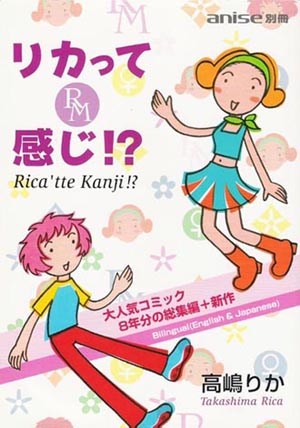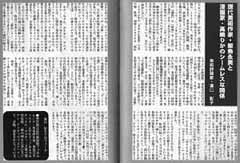 |
|
||||||||
「溝口彰子「現代美術家・飯島永美と漫画家・高嶋りかのシームレスな関係」
|
"Seamlesss relation between Rica Takashima, Fine Artist and RICA TAKASHIMA, Comic Artist, by Akiko Mizoguchi"
|
記事 (日本語) / Text[Japanese] |
|
 |
 |
記事 (英語) Text[English]
Rica'tte Kanji!?, Japanese version, Terra Publications,Japan, July 2003 "Seamlesss relation between Rica Takashima, Fine Artist and RICA TAKASHIMA, Comic Artist." by AKIKO MIZOGUCHI, ART CRITIC. RICA TAKASHIMA, manga artist, and Rica Takashima, performance artist, are one and the same individual. From 1994 to 2001, till right before she moved to the US, Rica had aggressively launched her Aozora Art shows in Tokyo, Fukuoka, Niigata, Ibaragi, and Aomori areas. The show's basic tenet is communication between participants and artists, and the process and result of communication are the integral part of her work. Aozora Art does not offer audience a piece of objects for possession; rather it sets a space for artistic interaction where people create collaboratively.To entice audience participation, Rica often uses a cutout board figure of humans and animals with a hole where people can show their faces through. It is the type of a board often seen in any given tourist attraction. Rica calls it "Kaodashi-kun" (a peek-a-boo board). In 1994, Rica launched an event called "Kisekae Kazoku" (Order Made Family). She constructed 20 Kaodashi-kun boards that depicted people with diverse age, gender, and nationality. Participants were encouraged to imagine his or her virtual family, such as "I, my friend, and pet," and choose appropriate boards for each character. Photos of virtual families were taken. Now which part of this is called art? The whole thing is, Rica would answer. Some participants in "Kisekae Kazoku" closely traced their actual families. Others wildly deviated from the traditional notion of the family based on blood relations and a heterosexual couple, by conceiving families of multi-nationalities, same-sex, and other nontraditional types. In this event, Rica successfully explored a very modern-day question on the definition of family. As she set out "Love Love Ceremony" in 1996, she became ever clearer as to what she wanted to inquire in her art. Using Kaodashi-kun boards, she told participants they could marry anyone, anything, and however many of them they pleased. Marriage licenses were issued (witnessed by Aozora Artists), pictures of virtual weddings were taken, and couples or groups walked down the aisle. Gay couples fulfilled their secrete wishes and some parent and child "got married." Rica's art is jam-packed with lighthearted and entertaining artistic trinkets. But they allure participants to become her co-conspirators without their knowing. For this reason, I call her art an activist art. Since 1996, Rica Takashima has engaged numerous people by setting a stage for creation and experimentation in projects like "Feeling Much Better with Cartoon" (1997), "Multiple Request Gallery" (1998, 2000), "Unlike Fake Tour" (1999), "Who's Miura?" (2000), and "Flier Art" (2000). There is no doubt she was not the first one to advocate an integration of the process of making art and people who participate in the making. First to come to my mind is Thai artist Rirkrit Tiravanija, who cooked and served Thai food to the bewildered visitors to his exhibition at a German museum. Keep in mind, however, that his culinary performance had to take place in a European museum in order for it to function as art. His audiences were elite art lovers like art critics and wealthy patrons who were invited to the opening gala; farthest away from ordinary people on a Bangkok street, or Harajyuku Square for that matter. Some of the most well-known Japanese cultural exports, such as Hello Kitty, Pokemon, Anime, and Otaku, share their roots in the country's contemporary pop culture. Japanese contemporary artists often incorporate such cultural icons into their internationally recognized works. They use Otaku and Anime as building pieces for their works to ensure they have acceptable formats in the existing art establishment. While I have no objection to such an approach, Rica Takashima clearly differs from the rest of her peers. Consider that everything about her is much removed from art in any traditional sense: her blonde locks and overly loud dress, choice of style in Kaodashi-kun board, the nature of the site where Aozora Art is produced and exhibited, that anyone can participate, that it is broadcasted on the Internet with no editing, and so on. Rica 's work is not, strictly speaking, art, but an opportunity or a possibility. Unlike aforementioned contemporary artists who merely borrow pop-ness from popular culture and rearranged it to serve the modern art scene, Rica herself embodies pop-ness. She is not looking to be accepted by the art establishment by appealing her pop character. Rather, she thinks the art establishment itself should become more like her; not so somber but happier, open-minded and more pop. It was no coincidence that RICA TAKASHIMA, comic artist was a guest speaker at Yuricon (2003), a manga conference that is considered to be the trendiest in the English language Otaku culture. It is no coincidence either that she created Rika 'tte Kanji!?, now re-released in this special issue of ANISE, a girl who is an icon of pop and subculture. Rica takashima now lives in New York City and is looking to break into the NY art scene. I hope she comes across people who can appreciate a real Rica takashima, who works outside the traditional museum circle and embodies the fine arts and popular culture simultaneously. Andy Warhol, the great master of pop art and the germinator of queer art (to me, at least), used to purposefully create moderately avant-garde works that suited curators' middle-class sensibility, or sweet-talk intellectual celebrities and wealthy patrons, in order to enhance his position in art circle. I wonder such clever maneuvers may help her to break into the NYC art establishment. It may not be necessary for her at all? Akiko Mizoguchi Profile Visiting researcher, Tokyo National Modern Art Museum Film Center. She is currently pursuing a Ph.D at University of Rochester Visual and Cultural Studies. She writes and speaks as a grass-roots liberal lesbian activist. |
|